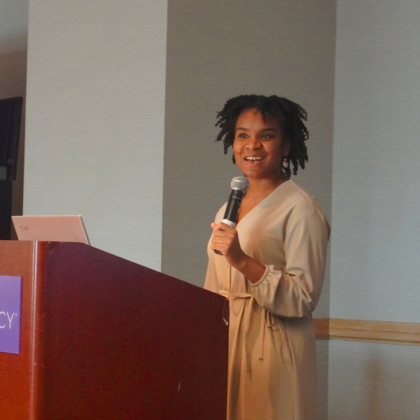In the late 1980s, the City of Detroit changed its maintenance policy and placed the responsibility for the upkeep of alleyways on homeowners. With limited resources to care for the spaces, many fell into disrepair and became illegal dumping sites. In 2020, the city reprioritized funding for these areas to be spaces for economic, environmental, and social revitalization. Canfield Consortium, a small local community development organization, embraced the opportunity to transform the alleyways in East Canfield and bring community members together to reimagine them as safe green corridors.

Unsurprising, flooding and heat-related challenges, exacerbated by climate change, are at the top of the priority list for residents. Tackling both climate concerns and the visual blight of vacant land at the same time, Canfield Consortium is transforming neglected alleyways into thriving community hubs with educational opportunities, art installations, and green infrastructure. While these activated community spaces are already providing multiple community benefits, their real power is helping community members visualize the hidden potential in their neighborhoods and think differently about what the future can hold.
Jalisa Gilmore, Senior Manager of Environmental Justice Programs at Groundwork USA, works with organizations like Canfield Consortium as part of our Equitable Development Technical Assistance Program to integrate equity-centered practices into their land reuse projects. What we’ve seen time and again is that while these powerful transformations are celebrated, the reality is that the success of the project is contingent on a solid foundation of trust. The project in East Canfield was only possible because the leadership of the Consortium first prioritized deep listening and designed the project to address the needs raised by residents specifically.
In this interview, Jalisa shares how equitable development best practices – like trust, transparency, and authenticity – can lead to more sustainable and impactful land transformation efforts that deliver the social, environmental, and health benefits communities seek.
- What do you mean by equitable development practices, and why are they so important?
Equitable development is about pursuing justice for those who have faced historical injustices. We know that there are vacant properties from past industries that are potentially contaminated and causing harm to the nearby communities. And this isn’t random. Due to a history of discriminatory housing policies, past and present industries are located primarily in communities of color and low-income areas. Through equitable development best practices, our Technical Assistance helps community organizations and nonprofits design processes that engage residents as the champions of change in their community, prioritize community needs, and prevent future harm.
Equitable development is also about ensuring that residents benefit fully from these transformations. Creating a new park or green space is only impactful if those living in the neighborhood get to enjoy these spaces. Unfortunately, without careful planning, displacement can happen when an area is beautified by driving up property value and rent. When residents are involved in decision-making processes, like they were in the Canfield project, and have a voice in the planning and implementation of redevelopment projects, they are more likely to advocate for solutions that minimize displacement and prioritize the community’s well-being.

- From your experience, how does incorporating diverse perspectives and knowledge from community members enhance the potential for successful, long-term change?
Brownfield projects often stretch over long periods. It’s not uncommon for local government officials, developers, or nonprofit practitioners to move on to new roles, which can result in a loss of institutional knowledge and delays in the project. However, the community is there for the long haul. Involving residents from the start means local knowledge remains available during transitions and can be passed on to new partners stepping in to support the project. Embracing this wealth of wisdom can guide efforts toward creating a space that truly reflects the community’s hopes, dreams, and needs and ensures long-lasting solutions.
- What equitable development strategies ensure community needs and voices are at the forefront of land redevelopment initiatives?
Finding the right approach isn’t one-size-fits-all. But every organization can begin by getting to know its community. Take the time to get to know the folks who live there – their needs, history, concerns, and what they care about. Once you understand who your community is, team up with a local partner who’s on the same page. Working together ensures that what you’re doing aligns with what the community wants. Be sure to pay attention to what’s already happening in the neighborhood – there might be some great initiatives already in motion that you can support and build on!

- How can organizations support one another to overcome challenges and keep moving forward in the brownfield redevelopment process?
It’s all about moving at the speed of trust. While there may be hurdles along the way, investing time in meaningful community engagement will set you up for success. Building trust and aligning priorities with the community may extend the project timeline, but it paves the way for smoother progress without community pushback, and it fosters more sustainable, long-lasting solutions.
Moreover, numerous brownfield planning and funding resources exist to support organizations in remediation efforts. Through our Equitable Development Technical Assistance Program at Groundwork USA, we provide coaching to alleviate the overwhelming feeling and simplify the process for nonprofits. So you don’t have to do it alone. In fact, you can’t do it alone. Organizations like Groundwork USA can help to facilitate the changes communities desire and need for their social, economic, and physical well-being.
